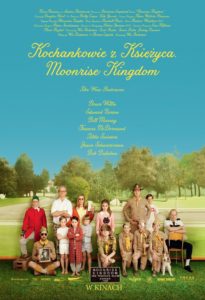Moonrise Kingdom
Tatsiana Rudkova
Studentka Instytutu Filologii Angielskiej Uniwersytetu Wrocławskiego (pod kierunkiem dr Justyny Deszcz-Tryhubczak)
A movie of fascinating pace, hectic and transcendent simultaneously, „Moonrise Kingdom” gradually washes off shores of an imaginary island that gave shelter to innocent pubertal dreams and troubled family memories, the island that had become „a whole new world” for a couple of romantic runaways. By the end of the film, Suzy and Sam (the 12-year-old main protagonists) are set to enter a whole new life — the life of grownup, married children who know they can overcome all kinds of hardships, from a lightning strike to societal dismay, together.
The 2012 movie features names that are a trademark of high quality acting and interesting story-telling: Tilda Swinton (a perfect uncountable Social Services who goes by the book in all circumstances), Bill Murray („a-father-with-an-axe” who is eternally sad and voluntarily invisible in the story), Bruce Willis (a conscientious police officer with an unexpected romance hidden in the bushes), or Edward Norton (a Math teacher devoted to the Scouts’ movement who does his best to keep things in order). The cast is well supported by beautifully awkward and vibrant child-actors who appear as equal rivals to adults.
Anderson exposes the fragility of child-adult relations, first of all, in a relationship between children and their parents. It is never articulated whether Suzy and Sam are seeking family or escaping from one. Overprotectiveness and neglect are neighboring motifs Anderson explores to criticize the social conventions of marriage and family (or lack thereof). The issue of unapproved personalities in a family, on the other hand, is introduced with a hope for reconciliation (consider, for example, the bath scene between Suzy and her mother). Social hierarchies are also questioned —twists of action ensure unexpected outcomes for those who stand on each end of the ladder.
A closer look into technical, visual and sound workings of the film may add to the viewers’ understanding of its uniqueness. A very special universe into which Wes Anderson transplants his movies , obviously, dictated some of the unique features. Parts of „Moonrise Kingdom” are shot in almost perfect symmetry, which makes the sequence transcendent and calming, yet attracts attention of the viewer to items of particular importance. The film is full of smallest (and sweetest) details. The viewer is sure to want to freeze the playback at particular moments and search for visual pearls hidden deep in the frame. The palette of the movie is rich in pale golds, blues and khakis. The colors get intensified according to the pitch of the characters’ emotions or scenes at stake (e.g., Sam’s calm betrayal by his foster family is almost totally yellow). The camera is often detached and produces vintage-like visual textures. Anderson juggles with filming techniques, giving out doll-box frames and maintaining large distances at hand. Sound is also an important part of this film. „The Young Peron’s Guide to the Orchestra” by Benjamin Britten marks points of viewers’ entry into the story and their exit from it.
„Moonrise Kingdom” received a 7.8 IMDB rating, which may seem like an understatement. Assuming that the film is neither a „morality tale”, nor part of an epic series where magicians with wands conquer the world, so be it. Yet, the sublime fantasy suggested by this movie comes as a perfect tool for parents who want to raise their children with sophisticated taste for colors, details and subtle action — future art house cinema-goers.

